人教新课标高一必修1 Unit 4 Earthquakes单元复习课件(66张)
文档属性
| 名称 | 人教新课标高一必修1 Unit 4 Earthquakes单元复习课件(66张) | 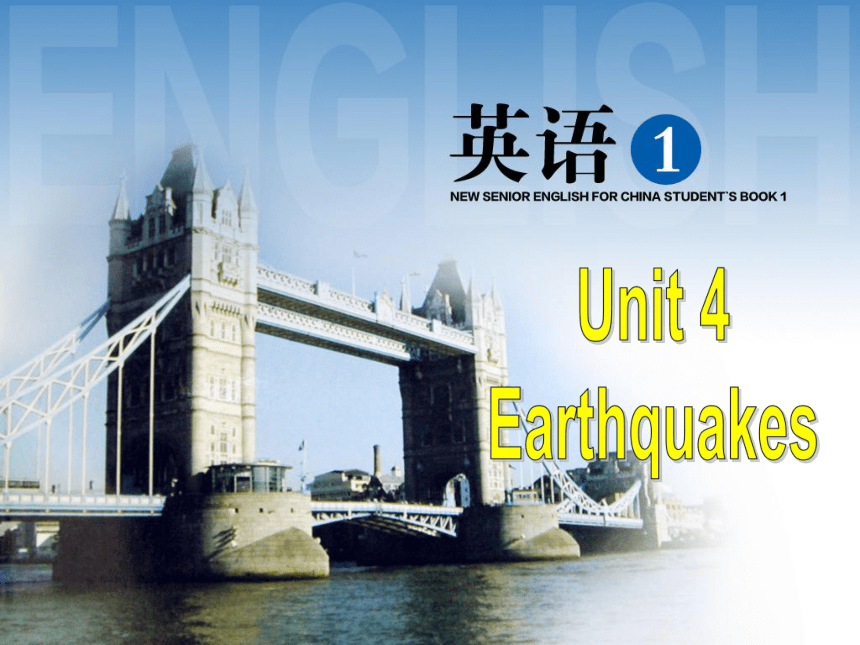 | |
| 格式 | zip | ||
| 文件大小 | 1018.8KB | ||
| 资源类型 | 教案 | ||
| 版本资源 | 人教版(新课程标准) | ||
| 科目 | 英语 | ||
| 更新时间 | 2017-01-18 10:30:09 | ||
图片预览


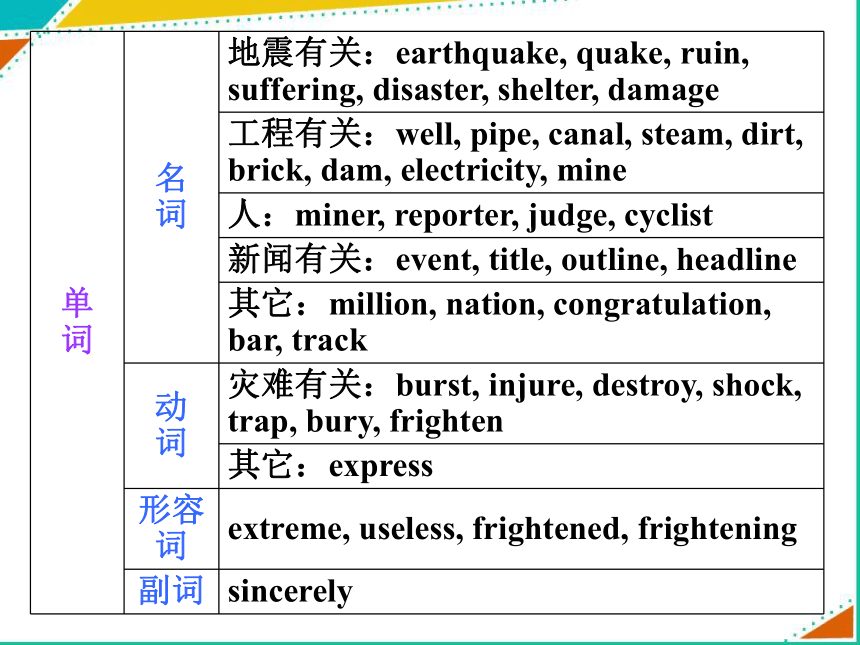

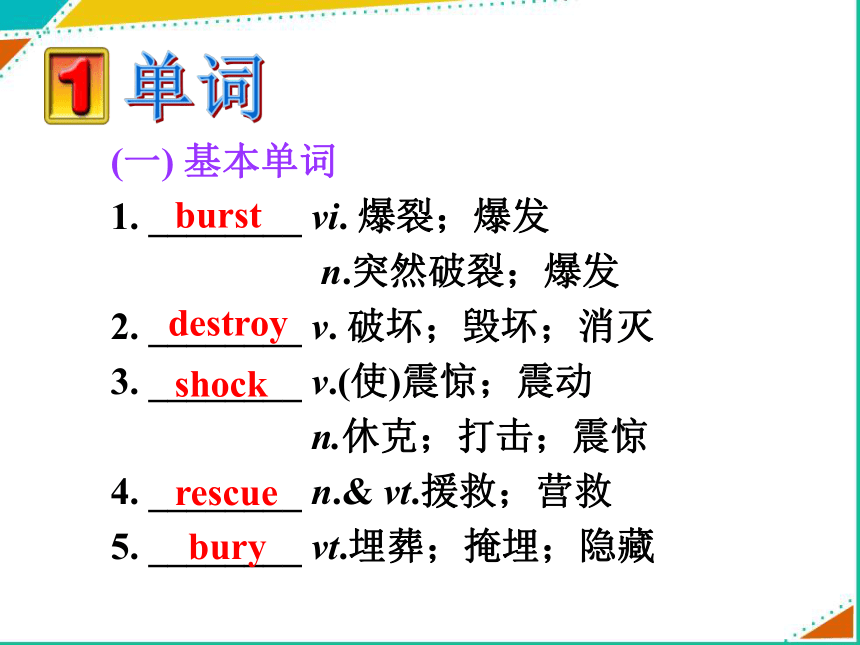
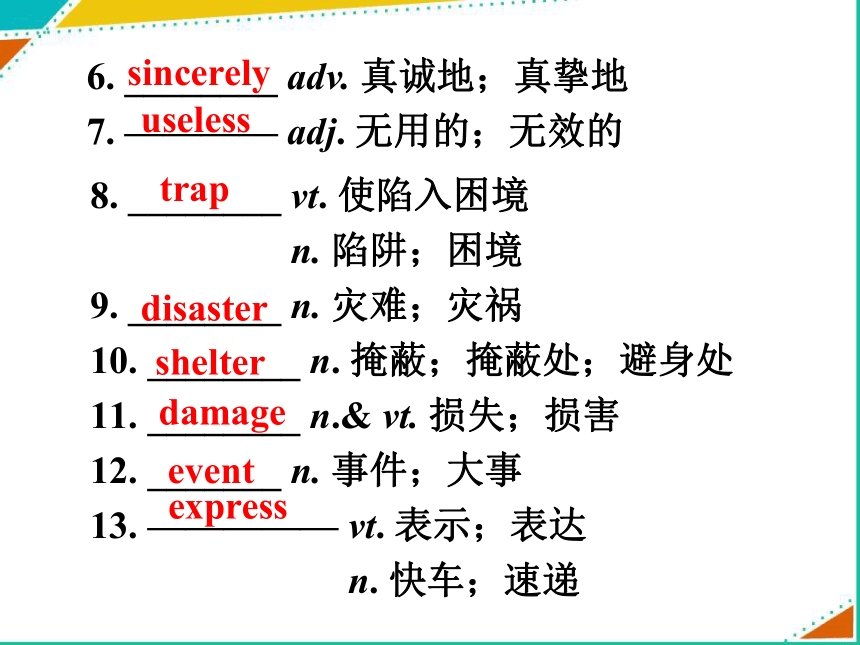
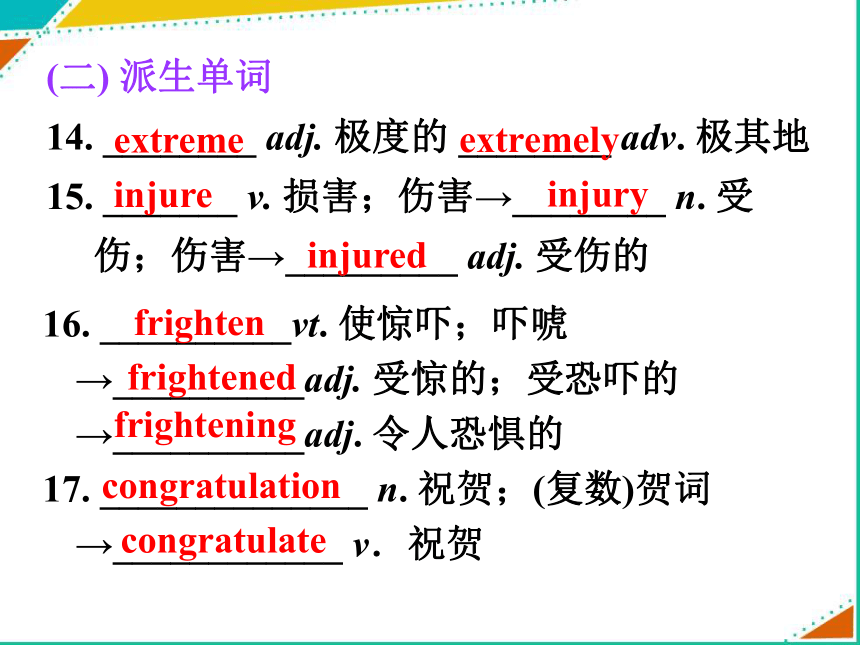
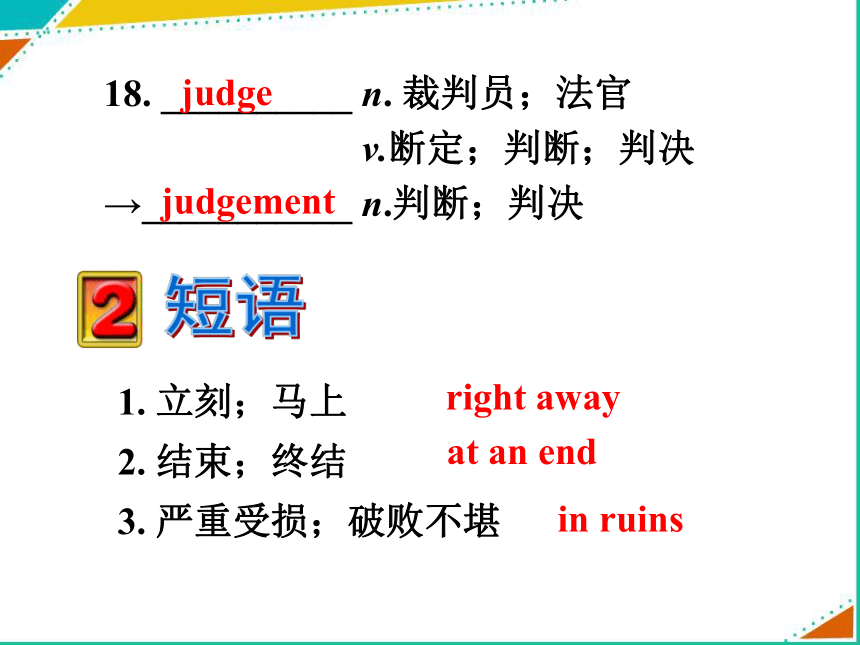
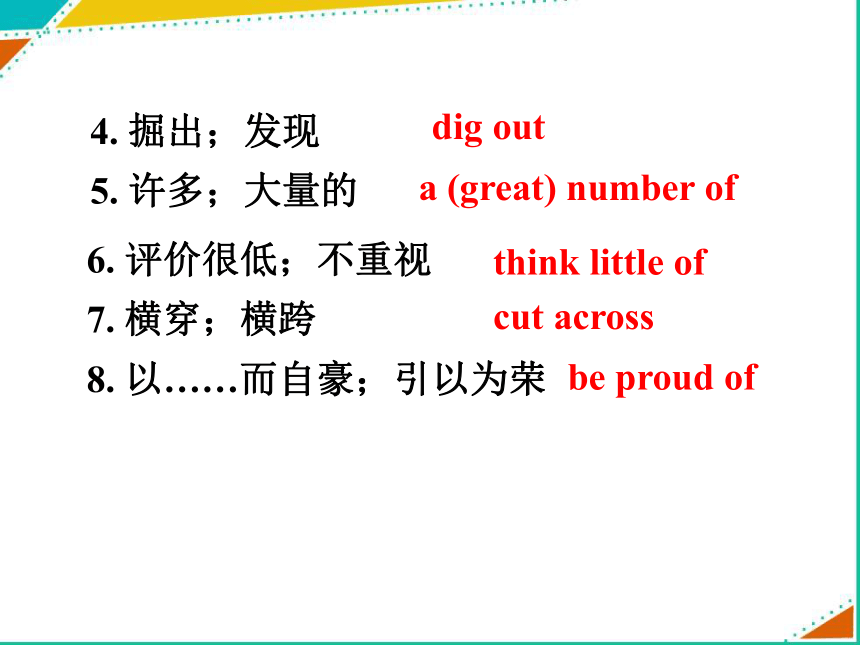

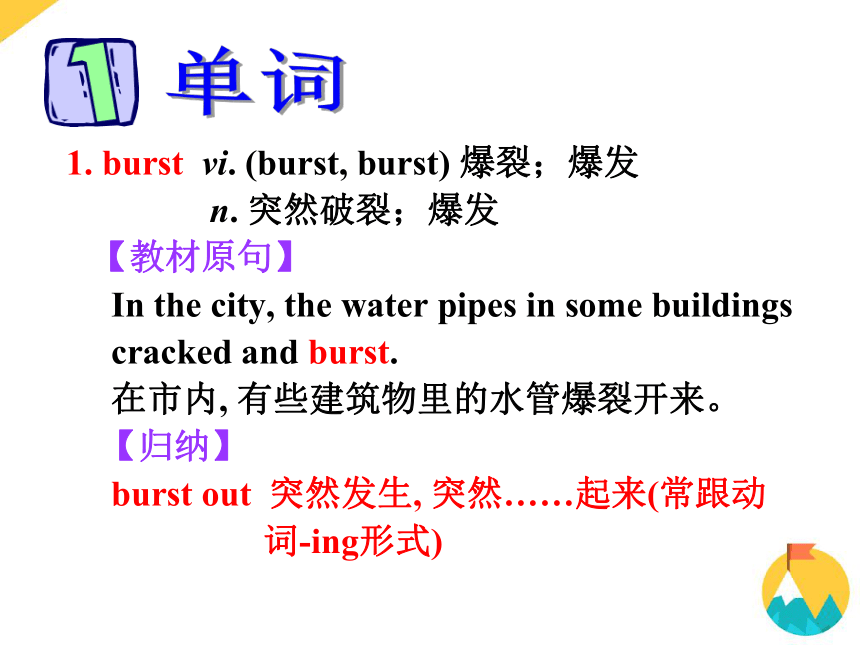

文档简介
课件66张PPT。Unit 4
Earthquakes知识清单 (一) 基本单词
1. ________ vi. 爆裂;爆发
n.突然破裂;爆发
2. ________ v. 破坏;毁坏;消灭
3. ________ v.(使)震惊;震动
n.休克;打击;震惊
4. ________ n.& vt.援救;营救
5. ________ vt.埋葬;掩埋;隐藏burstdestroyshockrescuebury单词8. ________ vt. 使陷入困境
n. 陷阱;困境
9. ________ n. 灾难;灾祸
10. ________ n. 掩蔽;掩蔽处;避身处
11. ________ n.& vt. 损失;损害
12. _______ n. 事件;大事
13. ————— vt. 表示;表达
n. 快车;速递trapdisastershelterdamageeventexpress6. ________ adv. 真诚地;真挚地
7. ———— adj. 无用的;无效的sincerelyuseless(二) 派生单词
14. ________ adj. 极度的 ________ adv. 极其地
15. _______ v. 损害;伤害→________ n. 受
伤;伤害→_________ adj. 受伤的extremeextremelyinjureinjuryinjured16. __________vt. 使惊吓;吓唬→__________adj. 受惊的;受恐吓的→__________adj. 令人恐惧的
17. ______________ n. 祝贺;(复数)贺词→____________ v.祝贺frightenfrightenedfrighteningcongratulationcongratulate18. __________ n. 裁判员;法官
v.断定;判断;判决
→___________ n.判断;判决judgejudgement1. 立刻;马上
2. 结束;终结
3. 严重受损;破败不堪right awayat an endin ruins短语4. 掘出;发现
5. 许多;大量的dig outa (great) number of6. 评价很低;不重视
7. 横穿;横跨
8. 以……而自豪;引以为荣 think little ofcut acrossbe proud of核心要点1. burst vi. (burst, burst) 爆裂;爆发
n. 突然破裂;爆发
【教材原句】
In the city, the water pipes in some buildings
cracked and burst.
在市内, 有些建筑物里的水管爆裂开来。
【归纳】
burst out 突然发生, 突然……起来(常跟动
词-ing形式) 单词e.g. “Don’t go!” he burst out.
Everyone in the room burst out laughing /
singing.
burst into 突然(进入某种状态)
e.g. Much to my surprise Ben suddenly burst into tears.
burst in on / upon 突然打断/插嘴
e.g. The boy burst in on our conversation.
burst with 满得快裂了, 装得满满的
e.g. That bag is bursting with potatoes.
burst n. 突然破裂; 爆发
e.g. There was a burst in the water pipe.On seeing Jay Chou appear on the stage, the audience ________ cheering.
burst in B. burst into
C. burst on D. burst out2. ruin n.[U] 毁坏; 毁灭; 崩溃
n. [C] (pl.) 废墟; 遗迹
v. (使)破产; (使)堕落; 毁灭
【教材原句】
In fifteen terrible seconds a large city lay in
ruins.
在可怕的15秒钟内, 一座大城市就沉沦在一
片废墟之中。【归纳】
① in ruins 严重受损;破败不堪
② fall in/into ruin 灭亡;荒废
③ bring...to ruin 使……毁灭; 使……没落
④ go/come to ruin 毁灭;落空
⑤ ruin oneself 毁掉自己
⑥ ruin one’s health/fame
毁坏某人的健康/名誉destroy用作动词,彻底破坏,无法修复。用于指希望,计划等被毁掉;程度上指毁灭性的。
ruin强调毁灭的彻底性,是一次性的行为,即人/物毁坏到不能复存或面目全非的地步或事后此物虽存在,却已失去其优良的特征或特性。ruin既可作动词,也可作名词,表毁灭,破产。其名词复数形式表示废墟。destroy/ruin/damagedamage常指人的威信/名声或物品的外观/价值/用途等受到损坏,失去或降低其使用价值,即修理后还可以继续使用。既可作动词,也可作名词。其过去分词可用作形容词作定语。That car accident ________ all his life. After
that he was limited to a wheelchair.
A. damaged B. destroyed
C. harmed D. ruined3. injure vt. 损害; 伤害
【教材原句】
Two-thirds of them died or were injured
during the earthquake.
2/3的人在地震中死去或受伤。【拓展】
① injured adj. 受伤的
② the injured 伤员
③ injury n. 伤; 伤口; 伤害
④ do sb. an injury / do an injury to sb.
伤害某人injure 特指意外事故中造成的伤害。
hurt 作及物动词时,“受伤”;既可以指肉体上的伤害,也可指精神上/情感上的伤害;作不及物动词时,“(身体某个部分)疼痛”。injure/hurt/wound/harmwound 通常指由武器造成的伤害,如刀/枪等的伤害,尤其是指在战场上造成的伤害。
harm 用于表示精神或肉体上的伤害均可,有时也可指引起不安或不便。还可用于抽象事物,尤其是指不道德的事情。4. shock v. (使)震惊; 震动
n. 休克; 打击; 震惊
【教材原句】
People shocked. 人们惊呆了。 【归纳】
① be shocked at... 对……感到震惊
② be shocked to do sth. 做某事很震惊
③ be shocked that... 对……很震惊5. bury vt. 埋葬;掩埋;隐藏;使沉浸;
使专心;插入;刺入
【教材原句】
The army organized teams to dig out those who were trapped and to bury the dead.
部队人员组成小分队, 将受困的人们挖出来, 将死者掩埋。【归纳】
① bury oneself in sth.
使陷入;埋头(工作、学习)
② be buried in (doing) sth. 专心致志于某事
③ be buried in thought 在沉思中
④ bury in=put (sb./sth.) into (a grave, earth…)
把……埋入6. judge v. 判定;判断
n. 裁判员;法官
【教材原句】
Your speech was heard by a group of five judges, all of whom agreed that it was the best one this year.
评委会的五位评委听了你的演讲, 他们都认为你的演讲是今年最好的。【归纳】
①judging from/by从……上看,根据……判断
②as far as I can judge 据我判断,我认为
③judge sb./ sth. from/ by... 从……来判断
【提醒】
judging from/ by “从……上看, 根据……来判断”。句首时, 为独立成分, 不受句子主语和时态影响, 只用现在分词作状语。 短语1. at an end 终结; 结束
【教材原句】
It seemed as if the world was at an end.
世界似乎到了末日。【拓展】
① at the end of 在……尽头; 在……末端
② come to an end 结束
③ make ends meet 使收支相抵; 量入为出④ by the end of
到……结束时;到……时候为止
(常与完成时态连用)
⑤ bring sth. to an end 使某事结束,终止
⑥ in the end 最后;终于;最终
⑦ end up 结束;告终2. dig out 挖掘出; 发现; 翻找出
【教材原句】
The army organized teams to dig out
those who were trapped and to bury the
dead. 部队人员组成小分队, 将受困的人
们挖出来, 将死者掩埋。【拓展】
① dig into 调查; 钻研; 通过翻土把……
掺入土壤
② dig up 挖出; 掘出; 发现; 揭露
③ dig for sth. 挖寻某物3. a great number of 许多; 大量的
【教材原句】
Such a great number of people died because
the quake happened while they were
sleeping. 那么多人丧生是因为地震发生时人们正在睡觉。a great/ large number of
a great/ good many
quite a few/ a good few+ 可数名词复数many a
more than one + 单数可数名词
+ 单数谓语动词【归纳】【拓展】a great/ good deal of
a great/ large amount of
quite a little+ 不可数名词a lot /lots of
a great/ large quantity of
large quantities of+ 可数名词复数
或不可数名词1. It seemed as if the world was at an end.
世界似乎到了末日。
It seems as if/as though... 似乎是……
as if/as though引导的是表语从句, 从
句中可用陈述语气或虚拟语气。句式【提示】
如果as if/as though引导的从句是“主语+系动词”结构,且主/从句中主语相同,可省略从句主语和系动词,as if后就只剩下名词/不定式/形容词(短语)/介词短语或分词形式。2. Thousands of families were killed and many
children were left without parents.
成千上万个家庭遇难, 许多孩子变成了孤儿。
many children were left without parents为被动语态, without parents为主语补足语, 表主语的状态。句中leave表示使某人或某物处于某种状态。leave + 宾语 +现在分词 (doing): 表示动作正在进行
过去分词 (done): 表示被动完成
动词不定式 (to do/to be done): 表示将来的动作
形容词
介词短语
副词{}+ 表示状态归纳3. All hope was not lost.
不是所有的希望都破灭了。
表示部分否定的句型:
all ...not...= not all... 并非所有的……都……1) all, both, each, every, everybody, everything, completely, always, whole, entirely 等具有总括意义的代词、形容词和副词与否定词not连用,无论not位置如何,均构成部分否定,表示“并非都”的意思。2) no, none, never, nobody, nothing, neither, no one, nowhere, no more, no longer, no way 等表否定意义的词(组)与肯定式谓语一起使用构成“全部否定”。定语从句是在复合句中起定语作用,修饰某一名词、代词或整个主句的从句。被定语从句修饰的词叫先行词。引导定语从句的关系词有关系代词(that, which, who, whom, whose等)和关系副词(where, when, why等)。语法定语从句—关系代词1. 关系代词that与which
定语从句中, 关系代词that既可指人也可指物;
which一般用于指物。
e.g. My cousin is no longer the man that he used to be.
?????? The old town has narrow streets and small houses that / which are built close to each other.
?????? Parents should pay attention to the books which / that their kids read.通常使用that引导定语从句的情况:
①先行词为all, everything, anything, nothing, much, little,none等不定代词或先行词被only, few, little, no, all, every, very修饰时。
e.g. Don’t believe everything that he tells you.
All the presents that your friends give
you on your birthday should be put away.
② 当先行词同时包括人和物时。
e.g. Then they talked of the persons and
things that interested them.③ 当先行词前有序数词或形容词的最高级修饰时。
e.g. The first thing that must be done
now is to put up a tent.
Mount Huangshan is one of the
most beautiful mountains in China
that I’ve ever visited.2. 关系代词who与whom
????who指人,主格,作主语,一般可用that替换;whom指人,宾格,作宾语,非正式文体中可用who/that替换,也可省略。
????e.g. The man who/ that spoke to the
headmaster just now is our physics
teacher.
The woman (who/ whom/ that) we
met at the school gate is Wei Fang’s
mother.3. 关系代词whose
??? whose是who的所有格,作定语,起限定作用。whose引导定语从句时,先行词可以是人,也可以是物。
??? e.g. This is the famous doctor whose
daughter teaches in our school.
??? Would you please pass me the book
whose cover is blue?【即学即练】 用正确的关系代词填空。
1) This is the village __________ I ever visited last year.
2) I will always remember the days __________ I spent with my grandmother.
3) I will never forget the boy _________ ever helped me.
4) Mr. Smith lives in the room ________ door is green.
5) This is the best movie ________ we have seen this year.that / which that/which who / that?? whose that新闻报道是对最近发生的事实的报道。
【新闻报道五要素】
写新闻报道时,要交代清楚新闻的五要素,五个“W”:事件(What)、人物(Who)、时间(When)、地点(Where)和原因
(Why)。有时还要写明“H”(How)。写作如何用英语写新闻报道【新闻报道的构成】
新闻报道一般分为四个部分:标题、导语、
正文、结语。
1. 标题是新闻的题目,是编辑对最有新闻价值的内容所做的浓缩、概括、提炼和再创造。撰写标题是为了获取新闻要点、诠释新闻意义、吸引读者阅读。英语新闻标题常用一般现在时,以增强报道的新鲜感、现实感和直接感。2. 导语一般置于报道开头,作用是吸引读者的注意力,因此要求导语能高度概括文章内容,让读者一看就能了解整篇报道。新闻导语常用一句话描述主要的事实。
3. 正文是新闻报道的主要部分,它用充足的事实展现主题,对导语内容的进一步阐释。既要简洁,又要生动。同时应注意:
★避免使用被动语态,多用富含行为动词的陈述句。要简洁生动,省去不必要的词汇。
★抓住显著的细节进行深入描写。
★语法正确。作为一种媒体写作应特别讲究语法的准确性,以免产生不好的影响。要确保句子的完整性,主谓一致,形容词、副词、虚拟语气及从句等的使用要恰当。4. 结语一般是最后一句或最后一段话,通常对全文内容作概括性的总结,或对新闻事件的发展趋势作出预测。有时,作者根据报道的事实在结语中提出令人深思的问题。【写作任务】
假如你是校报的英语记者。根据所给提示,写一篇英语稿件,报道韩国“岁月”号客轮(South Korean Sewol ferry)沉没这一事件。
时间: 2014年4月16日上午8时58分
地点: 韩国西南海域
与事件相关的信息: ① 船上载有476人,大部分为参加郊游的高中生,有少量游客;② 政府营救不力以及船长和部分船员首先弃船逃离致使大部分人遇难,最后仅179人获救。注意: 1. 词数100左右(标题已给出,但不计入总词数);2. 可以适当增加细节,以使行文连贯。
Ferry sinks off South Korean coast
_______________________________________________________________________________________________________________【参考范文】
Ferry sinks off South Korean coast
At 8:58 am on the morning of April 16, 2014, the South Korean Sewol ferry sank into the cold waters of the Yellow Sea.
There were 476 people on board when the ferry sank off South Korea’s southwest coast. Most of the passengers were senior high school students who were on a school trip. 179 were saved but the rest were killed. It is reported that the government didn’t take proper measures to rescue the passengers who were trapped on the ship. The captain and some sailors abandoned the sinking ferry, which caused many passengers to die.
The accident shocked the whole world.
高考链接1. (2014·陕西改编)
— I got that job I wanted at the public
library.
— ________ (congratulate)! That’s good
news.
答案:Congratulations
句意:—我得到了那份我想要的在公共图书
馆的工作。
—祝贺你!真是个好消息。2. (2014·重庆改编)It was John who broke the
window. Why are you talking to me as if I
________ (do) it?
答案:had done 本题考查虚拟语气。
句意:打破窗户的是约翰。为什么你说得好像是我打破的似的?根据第一句话可知, 打破窗户的人并非“我”, 故此处应该用虚拟语气, 表示与事实相反。根据broke可知这件事情发生在过去, 故用过去完成时态, 表示与过去事实相反。3. (2013·辽宁改编)The accident caused some
damage ______ my car, but it’s nothing
serious.
答案:to cause/do damage to... 伤害……
句意: 这次的事故对我的车造成一些损伤,
但不严重。4. (2011·湖南改编)Jack wasn’t saying
anything, but the teacher smiled at him
________ if he had done something very
clever.
答案:as本题考查状语从句的引导词。
句意:杰克什么也没说, 但是老师朝他笑着, 就好像他做了非常聪明的事情。as if “好像”。巩固练习I. 用所给单词的正确形式填空。
1. Don’t lift that toolbox — you’ll do yourself a(n) ________ (injure)!
2. Water got into the radio, and now it is completely _______ (use).
3. The news came as a(n) ________ (shock) blow.
4. He wrote her a poem as a(n) _________ (express) of his love. injuryuselessshockingexpressionII. 翻译下列句子(含定语从句)。
1. 窗户朝南的那个房间是约翰的。
??????????????????????
??????????????????????????
2. 那些被困在废墟里的人们最终被救了出来。???
??????????????????????????????????????????? ?????The room whose window faces south
belongs to John.Those who were trapped under the ruins
finally got rescued.3. 在这本书里,大卫描写了他在中国看到的人和城市。
In the book, David described the people
and cities (that) he had seen in?China.III. 阅读材料, 在空白处填入适当内容(不多于3个单词)。
The thin outer layer of the earth is called the crust (地壳), 1. _______ is made up of cold fragile rock compared to the hot rock deep inside it. The crust is full of cracks called faults (断层). These faults can be hundreds of miles long but they 2. _________ (bury) deep under the ground and pushed tightly together, 3. _____ they cannot be seen. The forces that push these faults together also move them. whichare buried?soWhen the parts of the crust on either side of a fault get pushed 4. ____ different directions, some rock may break apart and cause vibrations (振动). These vibrations travel outwards and earthquakes take place. Earthquakes are very 5. __________ (frighten). Their vibrations can cause buildings 6. ________ (fall) down and leave entire cities in ruins. infrighteningto fallThe Tangshan earthquake in 1976 killed hundreds of thousands of people, and the 7. ________ (suffer) of those who survived was extreme. When an earthquake occurs beneath the sea, 8. ____ can cause a series of waves called a tsunami, which can cause enormous damage to coastal areas. The 2004 tsunami hit the coasts of Indonesia, Sri Lanka and Thailand, 9. _______ (kill) over two hundred thousand people. That’s really 10. ___ disaster.suffering?itkillinga
Earthquakes知识清单 (一) 基本单词
1. ________ vi. 爆裂;爆发
n.突然破裂;爆发
2. ________ v. 破坏;毁坏;消灭
3. ________ v.(使)震惊;震动
n.休克;打击;震惊
4. ________ n.& vt.援救;营救
5. ________ vt.埋葬;掩埋;隐藏burstdestroyshockrescuebury单词8. ________ vt. 使陷入困境
n. 陷阱;困境
9. ________ n. 灾难;灾祸
10. ________ n. 掩蔽;掩蔽处;避身处
11. ________ n.& vt. 损失;损害
12. _______ n. 事件;大事
13. ————— vt. 表示;表达
n. 快车;速递trapdisastershelterdamageeventexpress6. ________ adv. 真诚地;真挚地
7. ———— adj. 无用的;无效的sincerelyuseless(二) 派生单词
14. ________ adj. 极度的 ________ adv. 极其地
15. _______ v. 损害;伤害→________ n. 受
伤;伤害→_________ adj. 受伤的extremeextremelyinjureinjuryinjured16. __________vt. 使惊吓;吓唬→__________adj. 受惊的;受恐吓的→__________adj. 令人恐惧的
17. ______________ n. 祝贺;(复数)贺词→____________ v.祝贺frightenfrightenedfrighteningcongratulationcongratulate18. __________ n. 裁判员;法官
v.断定;判断;判决
→___________ n.判断;判决judgejudgement1. 立刻;马上
2. 结束;终结
3. 严重受损;破败不堪right awayat an endin ruins短语4. 掘出;发现
5. 许多;大量的dig outa (great) number of6. 评价很低;不重视
7. 横穿;横跨
8. 以……而自豪;引以为荣 think little ofcut acrossbe proud of核心要点1. burst vi. (burst, burst) 爆裂;爆发
n. 突然破裂;爆发
【教材原句】
In the city, the water pipes in some buildings
cracked and burst.
在市内, 有些建筑物里的水管爆裂开来。
【归纳】
burst out 突然发生, 突然……起来(常跟动
词-ing形式) 单词e.g. “Don’t go!” he burst out.
Everyone in the room burst out laughing /
singing.
burst into 突然(进入某种状态)
e.g. Much to my surprise Ben suddenly burst into tears.
burst in on / upon 突然打断/插嘴
e.g. The boy burst in on our conversation.
burst with 满得快裂了, 装得满满的
e.g. That bag is bursting with potatoes.
burst n. 突然破裂; 爆发
e.g. There was a burst in the water pipe.On seeing Jay Chou appear on the stage, the audience ________ cheering.
burst in B. burst into
C. burst on D. burst out2. ruin n.[U] 毁坏; 毁灭; 崩溃
n. [C] (pl.) 废墟; 遗迹
v. (使)破产; (使)堕落; 毁灭
【教材原句】
In fifteen terrible seconds a large city lay in
ruins.
在可怕的15秒钟内, 一座大城市就沉沦在一
片废墟之中。【归纳】
① in ruins 严重受损;破败不堪
② fall in/into ruin 灭亡;荒废
③ bring...to ruin 使……毁灭; 使……没落
④ go/come to ruin 毁灭;落空
⑤ ruin oneself 毁掉自己
⑥ ruin one’s health/fame
毁坏某人的健康/名誉destroy用作动词,彻底破坏,无法修复。用于指希望,计划等被毁掉;程度上指毁灭性的。
ruin强调毁灭的彻底性,是一次性的行为,即人/物毁坏到不能复存或面目全非的地步或事后此物虽存在,却已失去其优良的特征或特性。ruin既可作动词,也可作名词,表毁灭,破产。其名词复数形式表示废墟。destroy/ruin/damagedamage常指人的威信/名声或物品的外观/价值/用途等受到损坏,失去或降低其使用价值,即修理后还可以继续使用。既可作动词,也可作名词。其过去分词可用作形容词作定语。That car accident ________ all his life. After
that he was limited to a wheelchair.
A. damaged B. destroyed
C. harmed D. ruined3. injure vt. 损害; 伤害
【教材原句】
Two-thirds of them died or were injured
during the earthquake.
2/3的人在地震中死去或受伤。【拓展】
① injured adj. 受伤的
② the injured 伤员
③ injury n. 伤; 伤口; 伤害
④ do sb. an injury / do an injury to sb.
伤害某人injure 特指意外事故中造成的伤害。
hurt 作及物动词时,“受伤”;既可以指肉体上的伤害,也可指精神上/情感上的伤害;作不及物动词时,“(身体某个部分)疼痛”。injure/hurt/wound/harmwound 通常指由武器造成的伤害,如刀/枪等的伤害,尤其是指在战场上造成的伤害。
harm 用于表示精神或肉体上的伤害均可,有时也可指引起不安或不便。还可用于抽象事物,尤其是指不道德的事情。4. shock v. (使)震惊; 震动
n. 休克; 打击; 震惊
【教材原句】
People shocked. 人们惊呆了。 【归纳】
① be shocked at... 对……感到震惊
② be shocked to do sth. 做某事很震惊
③ be shocked that... 对……很震惊5. bury vt. 埋葬;掩埋;隐藏;使沉浸;
使专心;插入;刺入
【教材原句】
The army organized teams to dig out those who were trapped and to bury the dead.
部队人员组成小分队, 将受困的人们挖出来, 将死者掩埋。【归纳】
① bury oneself in sth.
使陷入;埋头(工作、学习)
② be buried in (doing) sth. 专心致志于某事
③ be buried in thought 在沉思中
④ bury in=put (sb./sth.) into (a grave, earth…)
把……埋入6. judge v. 判定;判断
n. 裁判员;法官
【教材原句】
Your speech was heard by a group of five judges, all of whom agreed that it was the best one this year.
评委会的五位评委听了你的演讲, 他们都认为你的演讲是今年最好的。【归纳】
①judging from/by从……上看,根据……判断
②as far as I can judge 据我判断,我认为
③judge sb./ sth. from/ by... 从……来判断
【提醒】
judging from/ by “从……上看, 根据……来判断”。句首时, 为独立成分, 不受句子主语和时态影响, 只用现在分词作状语。 短语1. at an end 终结; 结束
【教材原句】
It seemed as if the world was at an end.
世界似乎到了末日。【拓展】
① at the end of 在……尽头; 在……末端
② come to an end 结束
③ make ends meet 使收支相抵; 量入为出④ by the end of
到……结束时;到……时候为止
(常与完成时态连用)
⑤ bring sth. to an end 使某事结束,终止
⑥ in the end 最后;终于;最终
⑦ end up 结束;告终2. dig out 挖掘出; 发现; 翻找出
【教材原句】
The army organized teams to dig out
those who were trapped and to bury the
dead. 部队人员组成小分队, 将受困的人
们挖出来, 将死者掩埋。【拓展】
① dig into 调查; 钻研; 通过翻土把……
掺入土壤
② dig up 挖出; 掘出; 发现; 揭露
③ dig for sth. 挖寻某物3. a great number of 许多; 大量的
【教材原句】
Such a great number of people died because
the quake happened while they were
sleeping. 那么多人丧生是因为地震发生时人们正在睡觉。a great/ large number of
a great/ good many
quite a few/ a good few+ 可数名词复数many a
more than one + 单数可数名词
+ 单数谓语动词【归纳】【拓展】a great/ good deal of
a great/ large amount of
quite a little+ 不可数名词a lot /lots of
a great/ large quantity of
large quantities of+ 可数名词复数
或不可数名词1. It seemed as if the world was at an end.
世界似乎到了末日。
It seems as if/as though... 似乎是……
as if/as though引导的是表语从句, 从
句中可用陈述语气或虚拟语气。句式【提示】
如果as if/as though引导的从句是“主语+系动词”结构,且主/从句中主语相同,可省略从句主语和系动词,as if后就只剩下名词/不定式/形容词(短语)/介词短语或分词形式。2. Thousands of families were killed and many
children were left without parents.
成千上万个家庭遇难, 许多孩子变成了孤儿。
many children were left without parents为被动语态, without parents为主语补足语, 表主语的状态。句中leave表示使某人或某物处于某种状态。leave + 宾语 +现在分词 (doing): 表示动作正在进行
过去分词 (done): 表示被动完成
动词不定式 (to do/to be done): 表示将来的动作
形容词
介词短语
副词{}+ 表示状态归纳3. All hope was not lost.
不是所有的希望都破灭了。
表示部分否定的句型:
all ...not...= not all... 并非所有的……都……1) all, both, each, every, everybody, everything, completely, always, whole, entirely 等具有总括意义的代词、形容词和副词与否定词not连用,无论not位置如何,均构成部分否定,表示“并非都”的意思。2) no, none, never, nobody, nothing, neither, no one, nowhere, no more, no longer, no way 等表否定意义的词(组)与肯定式谓语一起使用构成“全部否定”。定语从句是在复合句中起定语作用,修饰某一名词、代词或整个主句的从句。被定语从句修饰的词叫先行词。引导定语从句的关系词有关系代词(that, which, who, whom, whose等)和关系副词(where, when, why等)。语法定语从句—关系代词1. 关系代词that与which
定语从句中, 关系代词that既可指人也可指物;
which一般用于指物。
e.g. My cousin is no longer the man that he used to be.
?????? The old town has narrow streets and small houses that / which are built close to each other.
?????? Parents should pay attention to the books which / that their kids read.通常使用that引导定语从句的情况:
①先行词为all, everything, anything, nothing, much, little,none等不定代词或先行词被only, few, little, no, all, every, very修饰时。
e.g. Don’t believe everything that he tells you.
All the presents that your friends give
you on your birthday should be put away.
② 当先行词同时包括人和物时。
e.g. Then they talked of the persons and
things that interested them.③ 当先行词前有序数词或形容词的最高级修饰时。
e.g. The first thing that must be done
now is to put up a tent.
Mount Huangshan is one of the
most beautiful mountains in China
that I’ve ever visited.2. 关系代词who与whom
????who指人,主格,作主语,一般可用that替换;whom指人,宾格,作宾语,非正式文体中可用who/that替换,也可省略。
????e.g. The man who/ that spoke to the
headmaster just now is our physics
teacher.
The woman (who/ whom/ that) we
met at the school gate is Wei Fang’s
mother.3. 关系代词whose
??? whose是who的所有格,作定语,起限定作用。whose引导定语从句时,先行词可以是人,也可以是物。
??? e.g. This is the famous doctor whose
daughter teaches in our school.
??? Would you please pass me the book
whose cover is blue?【即学即练】 用正确的关系代词填空。
1) This is the village __________ I ever visited last year.
2) I will always remember the days __________ I spent with my grandmother.
3) I will never forget the boy _________ ever helped me.
4) Mr. Smith lives in the room ________ door is green.
5) This is the best movie ________ we have seen this year.that / which that/which who / that?? whose that新闻报道是对最近发生的事实的报道。
【新闻报道五要素】
写新闻报道时,要交代清楚新闻的五要素,五个“W”:事件(What)、人物(Who)、时间(When)、地点(Where)和原因
(Why)。有时还要写明“H”(How)。写作如何用英语写新闻报道【新闻报道的构成】
新闻报道一般分为四个部分:标题、导语、
正文、结语。
1. 标题是新闻的题目,是编辑对最有新闻价值的内容所做的浓缩、概括、提炼和再创造。撰写标题是为了获取新闻要点、诠释新闻意义、吸引读者阅读。英语新闻标题常用一般现在时,以增强报道的新鲜感、现实感和直接感。2. 导语一般置于报道开头,作用是吸引读者的注意力,因此要求导语能高度概括文章内容,让读者一看就能了解整篇报道。新闻导语常用一句话描述主要的事实。
3. 正文是新闻报道的主要部分,它用充足的事实展现主题,对导语内容的进一步阐释。既要简洁,又要生动。同时应注意:
★避免使用被动语态,多用富含行为动词的陈述句。要简洁生动,省去不必要的词汇。
★抓住显著的细节进行深入描写。
★语法正确。作为一种媒体写作应特别讲究语法的准确性,以免产生不好的影响。要确保句子的完整性,主谓一致,形容词、副词、虚拟语气及从句等的使用要恰当。4. 结语一般是最后一句或最后一段话,通常对全文内容作概括性的总结,或对新闻事件的发展趋势作出预测。有时,作者根据报道的事实在结语中提出令人深思的问题。【写作任务】
假如你是校报的英语记者。根据所给提示,写一篇英语稿件,报道韩国“岁月”号客轮(South Korean Sewol ferry)沉没这一事件。
时间: 2014年4月16日上午8时58分
地点: 韩国西南海域
与事件相关的信息: ① 船上载有476人,大部分为参加郊游的高中生,有少量游客;② 政府营救不力以及船长和部分船员首先弃船逃离致使大部分人遇难,最后仅179人获救。注意: 1. 词数100左右(标题已给出,但不计入总词数);2. 可以适当增加细节,以使行文连贯。
Ferry sinks off South Korean coast
_______________________________________________________________________________________________________________【参考范文】
Ferry sinks off South Korean coast
At 8:58 am on the morning of April 16, 2014, the South Korean Sewol ferry sank into the cold waters of the Yellow Sea.
There were 476 people on board when the ferry sank off South Korea’s southwest coast. Most of the passengers were senior high school students who were on a school trip. 179 were saved but the rest were killed. It is reported that the government didn’t take proper measures to rescue the passengers who were trapped on the ship. The captain and some sailors abandoned the sinking ferry, which caused many passengers to die.
The accident shocked the whole world.
高考链接1. (2014·陕西改编)
— I got that job I wanted at the public
library.
— ________ (congratulate)! That’s good
news.
答案:Congratulations
句意:—我得到了那份我想要的在公共图书
馆的工作。
—祝贺你!真是个好消息。2. (2014·重庆改编)It was John who broke the
window. Why are you talking to me as if I
________ (do) it?
答案:had done 本题考查虚拟语气。
句意:打破窗户的是约翰。为什么你说得好像是我打破的似的?根据第一句话可知, 打破窗户的人并非“我”, 故此处应该用虚拟语气, 表示与事实相反。根据broke可知这件事情发生在过去, 故用过去完成时态, 表示与过去事实相反。3. (2013·辽宁改编)The accident caused some
damage ______ my car, but it’s nothing
serious.
答案:to cause/do damage to... 伤害……
句意: 这次的事故对我的车造成一些损伤,
但不严重。4. (2011·湖南改编)Jack wasn’t saying
anything, but the teacher smiled at him
________ if he had done something very
clever.
答案:as本题考查状语从句的引导词。
句意:杰克什么也没说, 但是老师朝他笑着, 就好像他做了非常聪明的事情。as if “好像”。巩固练习I. 用所给单词的正确形式填空。
1. Don’t lift that toolbox — you’ll do yourself a(n) ________ (injure)!
2. Water got into the radio, and now it is completely _______ (use).
3. The news came as a(n) ________ (shock) blow.
4. He wrote her a poem as a(n) _________ (express) of his love. injuryuselessshockingexpressionII. 翻译下列句子(含定语从句)。
1. 窗户朝南的那个房间是约翰的。
??????????????????????
??????????????????????????
2. 那些被困在废墟里的人们最终被救了出来。???
??????????????????????????????????????????? ?????The room whose window faces south
belongs to John.Those who were trapped under the ruins
finally got rescued.3. 在这本书里,大卫描写了他在中国看到的人和城市。
In the book, David described the people
and cities (that) he had seen in?China.III. 阅读材料, 在空白处填入适当内容(不多于3个单词)。
The thin outer layer of the earth is called the crust (地壳), 1. _______ is made up of cold fragile rock compared to the hot rock deep inside it. The crust is full of cracks called faults (断层). These faults can be hundreds of miles long but they 2. _________ (bury) deep under the ground and pushed tightly together, 3. _____ they cannot be seen. The forces that push these faults together also move them. whichare buried?soWhen the parts of the crust on either side of a fault get pushed 4. ____ different directions, some rock may break apart and cause vibrations (振动). These vibrations travel outwards and earthquakes take place. Earthquakes are very 5. __________ (frighten). Their vibrations can cause buildings 6. ________ (fall) down and leave entire cities in ruins. infrighteningto fallThe Tangshan earthquake in 1976 killed hundreds of thousands of people, and the 7. ________ (suffer) of those who survived was extreme. When an earthquake occurs beneath the sea, 8. ____ can cause a series of waves called a tsunami, which can cause enormous damage to coastal areas. The 2004 tsunami hit the coasts of Indonesia, Sri Lanka and Thailand, 9. _______ (kill) over two hundred thousand people. That’s really 10. ___ disaster.suffering?itkillinga
